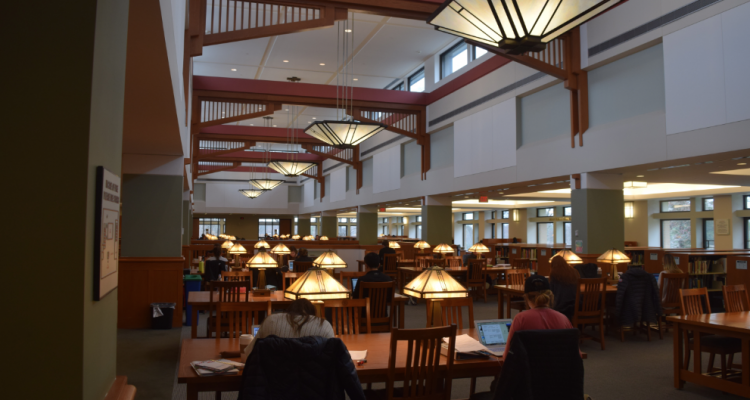The staff at the Academic and Career Development Center as well as the Writing Center and the Center for Academic Excellence have all been discussing the potential creation of an academic commons in the DiMenna-Nyselius Library. As of now, no decisions have been made to move any offices into or out of the library as they are in the discussion phase, according to Dr. Walter Rankin, Ph.D, the vice provost for continuing and professional studies.
Rankin noted, “Right now it’s completely open [the discussion]; the big takeaway is that we have literally just started the conversations. We’ve had two brown bag discussions that were open to all faculty and staff; those were well attended with around 30 people at each of those sessions. We’ve met with the Writing Center, we’ve met with people from ACDC…last night we had a fantastic meeting with the student advisory group for the library.”
Dr. Brent Mai, Ph.D, the dean of libraries at the University, noted that, “Academic libraries have witnessed a steady decline in the use of physically printed materials in recent years. This has not been an unexpected outcome of a maturing electronic age.”
“At Fairfield, where we have approximately 400,000 print volumes in our collections, this phenomenon hasn’t resulted in a decline in the number of books that are available for curricular and research support. Rather, we’ve added almost 900,000 ‘e-volumes’ to our collections – volumes we wouldn’t have had the space to shelve even if we’d had them in print format,” added Dr. Mai.
In terms of the logistics of the potential new academic space, Dr. Rankin stated, “We’re not changing the footprint of the library…this has been a conversation that’s been going on before I even got here… Basically that [the idea of an academic commons] plays into ‘Fairfield 2020’ [Fairfield University’s strategic plan to modernize and improve the school].”
“In one of our specific statements, we said that what we want to do is have these innovative spaces, but what does that mean? That’s what these discussions are about; how do we create an innovative space that’s really good for collaboration that’s not just your typical library from fifty years ago,” added Dr. Rankin.
Universities around the United States, such as Yale University in New Haven, Conn. for instance, have made use of similar academic or learning commons facilities. According to the description on Yale’s website, “At the heart of the Center for Teaching and Learning… the bright and open lobby features a welcome desk and numerous touchdown spaces for students and faculty from across the campus to work, collaborate and engage in conversation. One of the CTL’s guiding principles includes promoting a campus culture of open discussion about teaching and learning.”
At the University of Massachusetts in Amherst, the learning commons is characterized by a technology-rich environment, an integrated hub of student services provided by different university units, as well as a multipurpose center that is able to hold meetings, seminars and similar academic-related events.
Dr. Rankin felt as though, “We aren’t the new people on the block for an academic commons; lots of other libraries have led that discussion. This is something where other libraries have said, ‘you know what? We don’t need bound periodicals that have taken up massive amounts of room.’”
As for what this academic commons may entail, Dr. Rankin said that, “Last night, for example, [we were] talking to students. The student advisory board has students from all the schools, with grad students, undergraduate students… as we were talking with them, we got insights in that they kind of want three levels of sound.”
“You’ve got one level of sound, which is ‘we need a quiet space to study to legitimately sit with no interference’… Part two is that ‘we bring our friends to the library to study, but we come in groups and sit at the big tables, so it’s not complete quiet, but it’s also not chattering like you do in The Tully [The Daniel and Grace Tully Dining Commons]… and then having that third space which is these collaborative rooms, but we’ve heard loud and clear that people would love to see more of those types of spaces,” Dr. Rankin stated.
Sophomore Thomas Lezin advocates for more group spaces in the library, “I believe that adding more collaborative rooms will be beneficial to the school. Especially with the rising amount of students coming to Fairfield in the following years, the extra room will be needed for midterm weeks and finals week when the library is full.”
Dr. Mai added, “Since they [print editions of books and other texts] are getting less use, it’s hard to justify the large physical footprint that it takes to store them in the library building when that space could be used for other purposes. If you’re a frequent library user, you’ve undoubtedly noticed that we’ve done a considerable amount of shifting of the printed book collection – mostly into the compact shelving that’s located on the lower level of the building. This freed up space that we have re-purposed for use as student study space on the main and upper level.”
Essentially, this notion of reducing the physical footprint of print volumes in favor of online and more compact shelving of physical materials will allow for the creation of an academic commons here at Fairfield, which will help facilitate similar purposes to that of other universities’ respective learning commons facilities.
Ultimately, Dr. Mai highlighted that, “We [the library] are also re-thinking how we provide library services – and in what spaces. I would love to have the entire library staff located in one area of the library rather than being spread out as they are now in what seems like every corner of every floor. This could help us work better together as we support teaching and learning.”


Leave a Reply